Old Dominion Freight Line Bundle
How Does Old Dominion Freight Line Thrive in the Shipping Industry?
Old Dominion Freight Line (ODFL) stands as a cornerstone in North America's freight transportation network, facilitating crucial connections across diverse industries. Its consistent performance highlights its significance, even amidst economic fluctuations, solidifying its position as a leading shipping company. As of early 2024, ODFL continues to demonstrate strong financial health and operational efficiency within the competitive landscape of less-than-truckload (LTL) shipping.
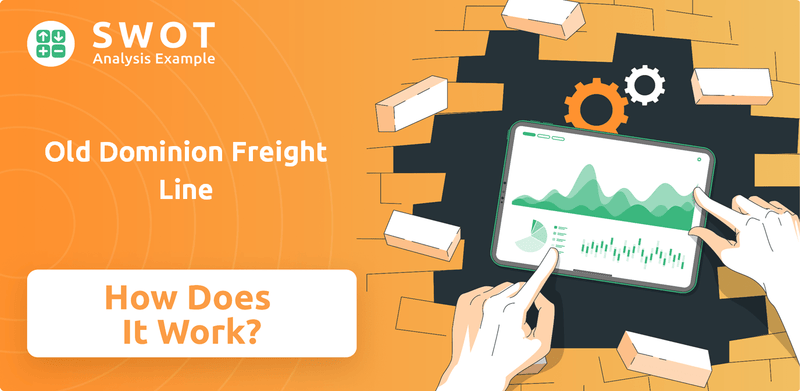
This exploration into Old Dominion Freight Line will uncover its operational strategies and financial performance. From understanding Old Dominion Freight Line SWOT Analysis to examining its core services, we'll delve into how it navigates the complexities of long-haul trucking and maintains a competitive edge. Whether you're interested in how to ship LTL with Old Dominion Freight Line or seeking insights into ODFL's financial performance, this analysis aims to provide a comprehensive understanding of this industry leader.
What Are the Key Operations Driving Old Dominion Freight Line’s Success?
The core operations of Old Dominion Freight Line (ODFL) center around its less-than-truckload (LTL) shipping services. This approach provides a cost-effective solution for businesses needing to transport goods in quantities that are too large for parcel carriers but not enough to fill an entire truckload. The company's success hinges on a sophisticated hub-and-spoke network designed to efficiently consolidate, transport, and deliver freight across its extensive service area.
The value proposition of ODFL lies in its ability to offer reliable and efficient freight transportation solutions. By focusing on LTL shipping, the company caters to a specific market segment, providing tailored services that optimize transit times and reduce shipping costs. This focus, combined with investments in technology and a commitment to customer satisfaction, has positioned ODFL as a leader in the freight transportation industry.
The operational process begins with freight pickup from customer locations. This freight is then transported to a local service center where it is sorted and loaded onto line-haul trailers. These trailers move between service centers across Old Dominion's integrated network, which is designed for optimal efficiency and speed. The company's union-free workforce is a key operational differentiator, allowing for greater flexibility and productivity in managing its extensive network of approximately 258 service centers and over 11,000 tractors and 45,000 trailers as of late 2023. Old Dominion's investment in technology, including advanced freight management systems, further enhances its operational effectiveness by optimizing routing, tracking, and delivery schedules. The company also emphasizes stringent safety protocols and driver training, contributing to its strong service reputation and reliability.
Freight is picked up from customer locations and transported to local service centers. At these centers, the freight is sorted and prepared for line-haul transportation. This initial step is crucial for ensuring efficient movement through the network.
Line-haul trailers transport freight between service centers across Old Dominion's network. This network is designed for optimal efficiency and speed, facilitating the movement of goods over long distances. The company's focus on efficiency is a key factor in its success.
Service centers play a vital role in sorting, consolidating, and preparing freight for delivery. These centers are strategically located to optimize the flow of goods. ODFL's network includes approximately 258 service centers.
Freight is delivered to the final recipients from the destination service centers. ODFL emphasizes reliable and timely delivery. The company's commitment to customer satisfaction is a key differentiator.
Old Dominion Freight Line distinguishes itself through its union-free workforce, which enhances flexibility and productivity. The company also invests heavily in technology to optimize routing and tracking. Furthermore, ODFL offers a range of specialized services.
- Expedited transportation for time-sensitive shipments.
- Supply chain consulting to optimize logistics operations.
- Truckload brokerage to provide flexibility for larger shipments.
- Focus on premium service and damage-free delivery.
Old Dominion Freight Line SWOT Analysis
- Complete SWOT Breakdown
- Fully Customizable
- Editable in Excel & Word
- Professional Formatting
- Investor-Ready Format
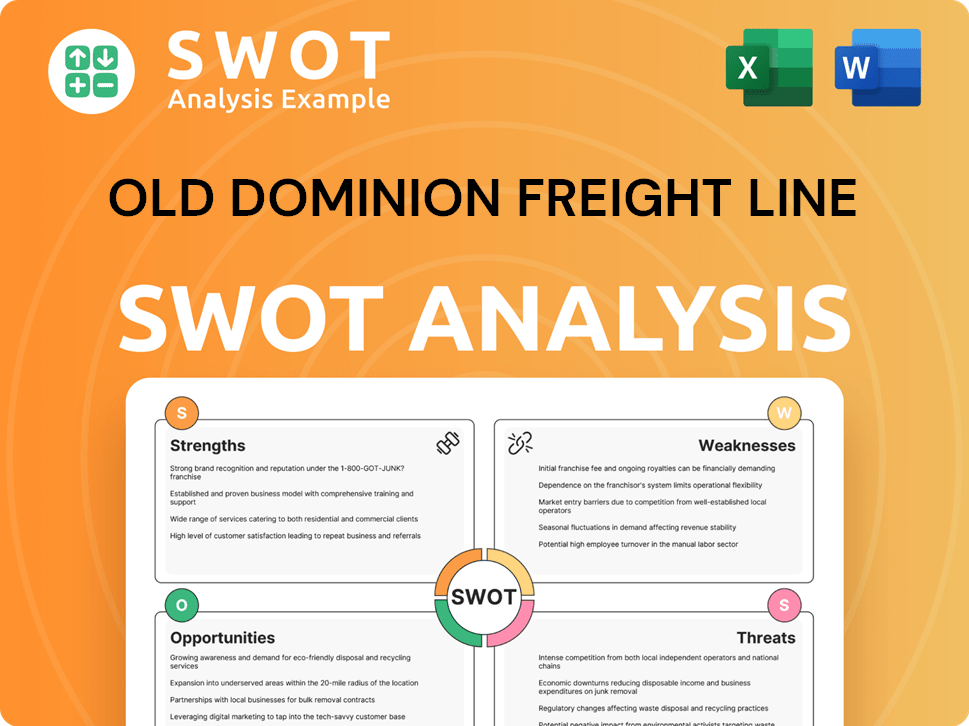
How Does Old Dominion Freight Line Make Money?
The primary revenue stream for Old Dominion Freight Line (ODFL) comes from its less-than-truckload (LTL) shipping services. This involves transporting freight from multiple customers in a single trailer, making it a cost-effective solution for businesses. ODFL's financial success is heavily reliant on its ability to efficiently manage and monetize these LTL operations.
Old Dominion's revenue model is built on a base rate per hundredweight, adjusted by factors like freight class, accessorial charges, and fuel surcharges. These additional charges cover services such as liftgate use or residential deliveries. In the first quarter of 2024, the company reported a total revenue of $1.52 billion, demonstrating the scale of its operations.
Beyond its core LTL services, Old Dominion Freight Line diversifies its revenue through value-added offerings. These include expedited ground and air transportation, which command higher rates, and supply chain consulting services. The company also provides truckload brokerage services, further expanding its service portfolio.
Old Dominion Freight Line's monetization strategy centers on premium service and operational efficiency. This approach allows the company to maintain strong pricing power within the LTL industry. The emphasis on consistent, on-time, and damage-free service fosters customer loyalty and willingness to pay for quality. For more insights, you can explore the Growth Strategy of Old Dominion Freight Line.
- LTL Shipping: This is the primary revenue generator, based on the volume, weight, and distance of freight transported.
- Value-Added Services: Expedited shipping, supply chain consulting, and truckload brokerage contribute to revenue diversification.
- Pricing Strategy: Base rates are adjusted by freight class, accessorial charges, and fuel surcharges.
- Efficiency and Premium Service: Focus on on-time, damage-free deliveries supports higher customer retention and pricing power.
Old Dominion Freight Line PESTLE Analysis
- Covers All 6 PESTLE Categories
- No Research Needed – Save Hours of Work
- Built by Experts, Trusted by Consultants
- Instant Download, Ready to Use
- 100% Editable, Fully Customizable
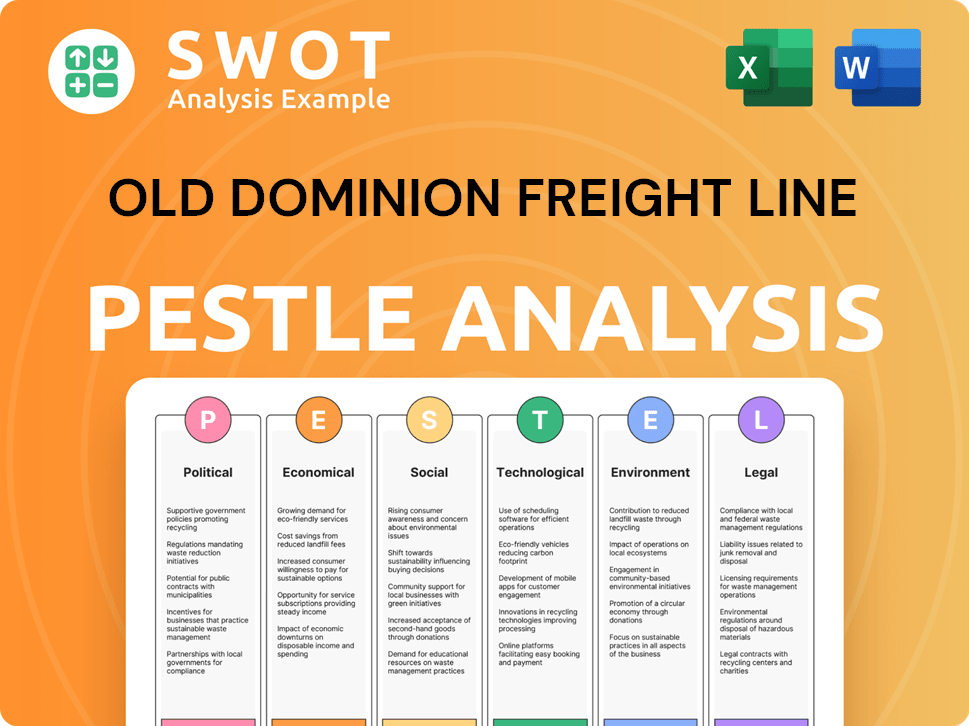
Which Strategic Decisions Have Shaped Old Dominion Freight Line’s Business Model?
The journey of Old Dominion Freight Line (ODFL) has been marked by strategic milestones and a consistent focus on operational excellence. This approach has allowed the company to navigate industry challenges and build a significant competitive edge in the freight transportation sector. A key strategic move has been the continuous investment in its integrated, union-free network, which has been a cornerstone of its success.
The expansion of its service center network, reaching approximately 258 locations as of late 2023, is a testament to this ongoing strategic expansion, enabling broader reach and improved transit times. This growth, coupled with investments in technology and a focus on customer service, has positioned Old Dominion as a leader in the Less-than-truckload (LTL) shipping market. The company's ability to adapt to market dynamics and maintain strong financial discipline has further solidified its position.
Old Dominion's commitment to technological adoption, including advanced freight management systems and real-time tracking capabilities, has been a key factor in improving operational efficiency and maintaining a competitive advantage. This focus on technology helps optimize routing, reduce transit times, and enhance supply chain visibility for its customers. The company's resilience in the face of industry challenges, such as economic downturns and fluctuating fuel prices, is evident in its financial performance. For example, despite a slight decrease in revenue in the first quarter of 2024 compared to the previous year, the company maintained a healthy operating ratio of 79.4%, reflecting its operational efficiency.
Old Dominion Freight Line has strategically invested in its integrated, union-free network, enhancing operational flexibility and customer service. The company has expanded its service center network to approximately 258 locations as of late 2023, increasing its reach. Continuous technological advancements, including freight management systems, have optimized routing and improved supply chain visibility.
The company's union-free workforce provides greater flexibility and control over labor costs, allowing for agile responses to market demands. Old Dominion focuses on premium service, characterized by high on-time delivery rates and low claims ratios, fostering strong customer loyalty. Economies of scale, stemming from its extensive network and high freight density, enable it to operate efficiently and offer competitive pricing.
Old Dominion has demonstrated resilience in the face of industry challenges, maintaining a strong balance sheet and disciplined cost management. Despite fluctuations, the company has shown consistent profitability. In the first quarter of 2024, the company maintained an operating ratio of 79.4%, reflecting its operational efficiency.
Old Dominion continues to adapt to new trends by focusing on service quality and network optimization. The company's focus on maintaining a strong competitive position in the dynamic freight industry is evident. For a deeper dive into the competitive landscape, consider reading about the Competitors Landscape of Old Dominion Freight Line.
Old Dominion Freight Line Business Model Canvas
- Complete 9-Block Business Model Canvas
- Effortlessly Communicate Your Business Strategy
- Investor-Ready BMC Format
- 100% Editable and Customizable
- Clear and Structured Layout
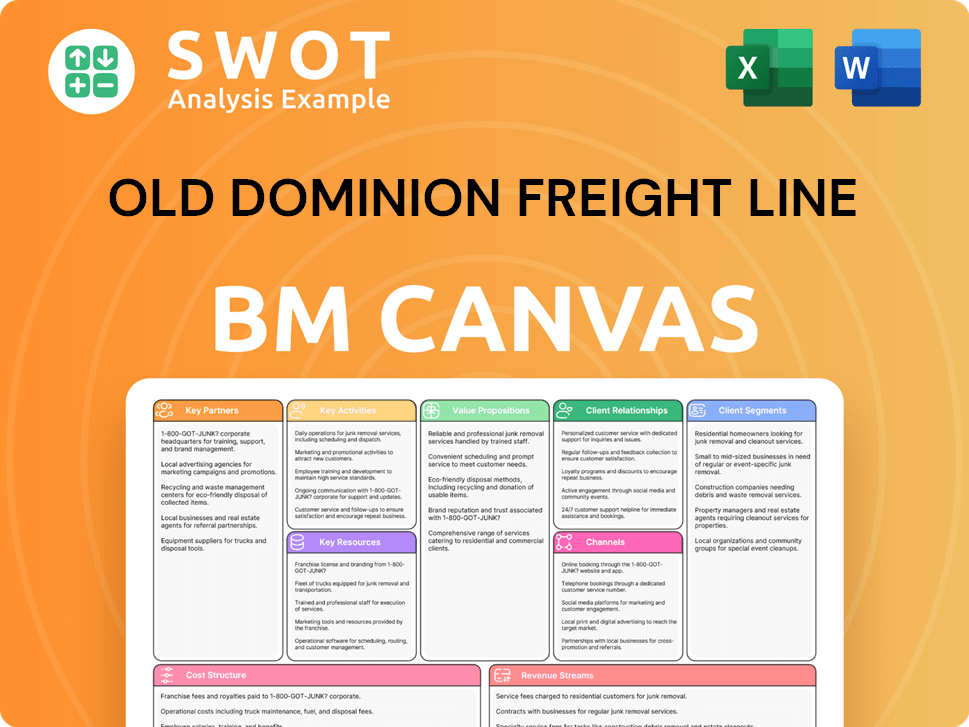
How Is Old Dominion Freight Line Positioning Itself for Continued Success?
Old Dominion Freight Line (ODFL) holds a prominent position within the less-than-truckload (LTL) freight industry. As a leading shipping company, it's recognized for its premium service and extensive network. Its strong market presence is supported by a commitment to customer satisfaction, which is reflected in its low claims ratio and high on-time delivery rates.
Despite its strengths, Old Dominion Freight Line faces risks, including economic downturns that can affect freight volumes. Regulatory changes and technological disruptions also pose challenges. The company competes with other LTL carriers and full truckload providers, which can impact profit margins. Understanding these factors is crucial for evaluating the company's performance and future prospects.
Old Dominion is consistently ranked among the top LTL carriers in North America. Its focus on premium service and operational efficiency sets it apart. The company's strong market share and customer loyalty are key indicators of its industry leadership.
Economic downturns can significantly reduce freight volumes. Regulatory changes and technological advancements require ongoing investment. Competition from other carriers can pressure profit margins. These factors pose challenges to Old Dominion's operations.
Old Dominion is focused on expanding its service center network and leveraging technological advancements. The company's long-term strategy emphasizes premium service, which is expected to drive market share gains. Sustainability and digital customer experience are areas of focus.
While specific figures fluctuate, Old Dominion has historically demonstrated strong financial health. Key metrics to watch include revenue growth, operating ratios, and return on equity. Investors can find detailed financial data in the Owners & Shareholders of Old Dominion Freight Line.
Old Dominion Freight Line is likely to explore enhancements in digital customer interfaces, predictive analytics for demand forecasting, and potentially alternative fuel vehicles to align with sustainability trends. The company's disciplined operational approach, strong financial health, and commitment to service excellence are key drivers for its future.
- Continued investment in service centers to enhance capacity and efficiency.
- Technological advancements to optimize operations and customer experience.
- Focus on digital customer interfaces and predictive analytics.
- Exploration of alternative fuel vehicles for sustainability.
Old Dominion Freight Line Porter's Five Forces Analysis
- Covers All 5 Competitive Forces in Detail
- Structured for Consultants, Students, and Founders
- 100% Editable in Microsoft Word & Excel
- Instant Digital Download – Use Immediately
- Compatible with Mac & PC – Fully Unlocked
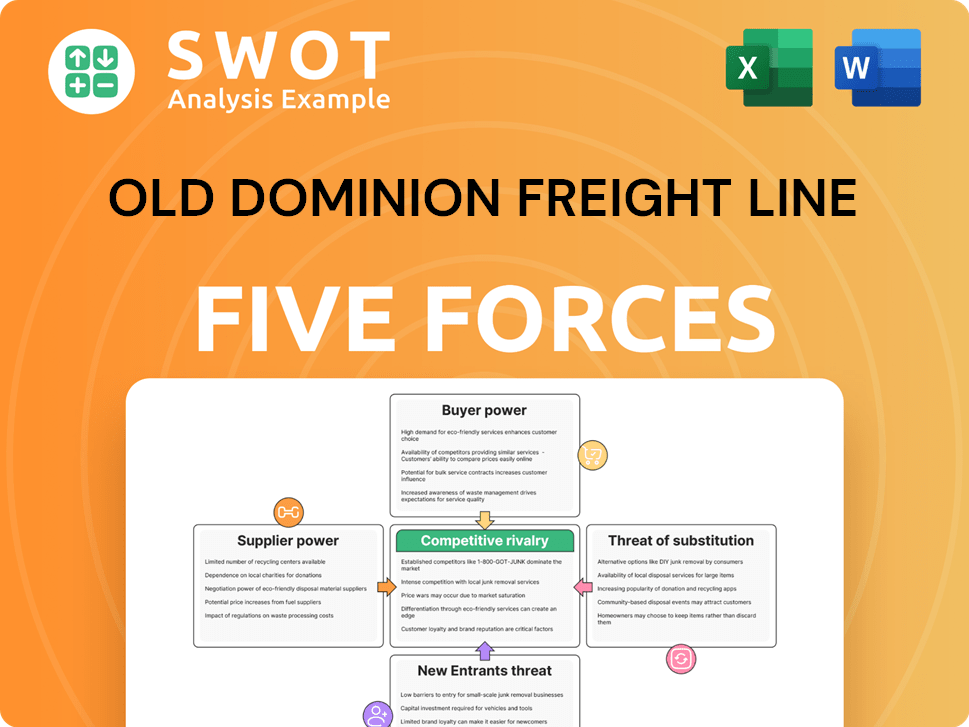
Related Blogs
- What are Mission Vision & Core Values of Old Dominion Freight Line Company?
- What is Competitive Landscape of Old Dominion Freight Line Company?
- What is Growth Strategy and Future Prospects of Old Dominion Freight Line Company?
- What is Sales and Marketing Strategy of Old Dominion Freight Line Company?
- What is Brief History of Old Dominion Freight Line Company?
- Who Owns Old Dominion Freight Line Company?
- What is Customer Demographics and Target Market of Old Dominion Freight Line Company?
Disclaimer
All information, articles, and product details provided on this website are for general informational and educational purposes only. We do not claim any ownership over, nor do we intend to infringe upon, any trademarks, copyrights, logos, brand names, or other intellectual property mentioned or depicted on this site. Such intellectual property remains the property of its respective owners, and any references here are made solely for identification or informational purposes, without implying any affiliation, endorsement, or partnership.
We make no representations or warranties, express or implied, regarding the accuracy, completeness, or suitability of any content or products presented. Nothing on this website should be construed as legal, tax, investment, financial, medical, or other professional advice. In addition, no part of this site—including articles or product references—constitutes a solicitation, recommendation, endorsement, advertisement, or offer to buy or sell any securities, franchises, or other financial instruments, particularly in jurisdictions where such activity would be unlawful.
All content is of a general nature and may not address the specific circumstances of any individual or entity. It is not a substitute for professional advice or services. Any actions you take based on the information provided here are strictly at your own risk. You accept full responsibility for any decisions or outcomes arising from your use of this website and agree to release us from any liability in connection with your use of, or reliance upon, the content or products found herein.